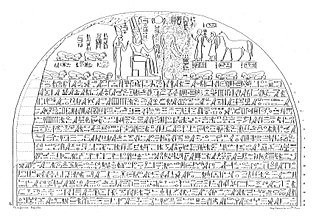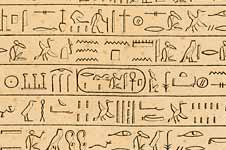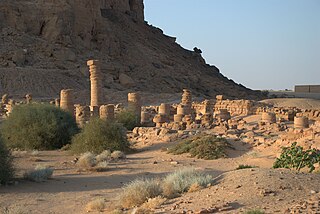
Taharqa, also spelled Taharka or Taharqo, was a pharaoh of the Twenty-fifth Dynasty of Egypt and qore (king) of the Kingdom of Kush, from 690 to 664 BC. He was one of the "Black Pharaohs" who ruled over Egypt for nearly a century.

Piye was an ancient Kushite king and founder of the Twenty-fifth Dynasty of Egypt, who ruled Egypt from 744–714 BC. He ruled from the city of Napata, located deep in Nubia, modern-day Sudan.

Jebel Barkal or Gebel Barkal is a mesa or large rock outcrop located 400 km north of Khartoum, next to Karima in Northern State in Sudan, on the Nile River, in the region that is sometimes called Nubia. The jebel is 104 m tall, has a flat top, and came to have religious significance for both ancient Kush and ancient Egyptian occupiers. In 2003, the mountain, together with the extensive archaeological site at its base, were named as the center of a World Heritage Site by UNESCO. The Jebel Barkal area houses the Jebel Barkal Museum.

Apedemak or Apademak was a major deity in the ancient Nubian and Kushite pantheon. Often depicted as a figure with a male human torso and a lion head, Apedemak was a war god worshiped by the Meroitic peoples inhabiting Kush. He has no Egyptian counterpart. As a war god, Apedemak came to symbolize martial power, military conquest, and empire for the Meroitic peoples. Apedemak is also closely associated with Amun, the state-sponsored Egyptian deity during the preceding Napatan period, and is assumed to hold an equal level of importance.

Alara was a King of Kush, who is generally regarded as the founder of the Napatan royal dynasty by his 25th Dynasty Kushite successors and was the first recorded prince of Kush. He unified all of Upper Nubia from Meroë to the Third Cataract and is possibly attested at the Temple of Amun at Kawa. Alara also established Napata as the religious capital of Kush. Alara himself was not a 25th dynasty Kushite king since he never controlled any region of Egypt during his reign compared to his two immediate successors: Kashta and Piye respectively. Nubian literature credits him with a substantial reign since future Nubian kings requested that they might enjoy a reign as long as Alara's. His memory was also central to the origin myth of the Kushite kingdom, which was embellished with new elements over time. Alara was a deeply revered figure in Nubian culture and the first Kushite king whose name came down to scholars.

Amanishakheto was a queen regnant (kandake) of Kush who reigned in the early 1st century AD. In Meroitic hieroglyphs her name is written "Amanikasheto". In Meroitic cursive she is referred to as Amaniskheto qor kd(ke) which means Amanishakheto, Qore and Kandake.

Senkamanisken was a Kushite King who ruled from 640 to 620 BC at Napata. He used royal titles based on those of the ancient Egyptian pharaohs.

Atlanersa was a Kushite ruler of the Napatan kingdom of Nubia, reigning for about a decade in the mid-7th century BC. He was the successor of Tantamani, the last ruler of the 25th Dynasty of Egypt, and possibly a son of Taharqa or less likely of Tantamani, while his mother was a queen whose name is only partially preserved. Atlanersa's reign immediately followed the collapse of Nubian control over Egypt, which witnessed the Assyrian conquest of Egypt and then the beginning of the Late Period under Psamtik I. The same period also saw the progressive cultural integration of Egyptian beliefs by the Kushite civilization.
Amun was a major ancient Egyptian deity who appears as a member of the Hermopolitan Ogdoad. Amun was attested from the Old Kingdom together with his wife Amunet. With the 11th Dynasty, Amun rose to the position of patron deity of Thebes by replacing Montu.

Nubia is a region along the Nile river encompassing the area between the first cataract of the Nile and the confluence of the Blue and White Niles, or more strictly, Al Dabbah. It was the seat of one of the earliest civilizations of ancient Africa, the Kerma culture, which lasted from around 2500 BC until its conquest by the New Kingdom of Egypt under Pharaoh Thutmose I around 1500 BC, whose heirs ruled most of Nubia for the next 400 years. Nubia was home to several empires, most prominently the Kingdom of Kush, which conquered Egypt in the eighth century BC during the reign of Piye and ruled the country as its 25th Dynasty.

The Kingdom of Kush, also known as the Kushite Empire, or simply Kush, was an ancient kingdom in Nubia, centered along the Nile Valley in what is now northern Sudan and southern Egypt.

The Twenty-fifth Dynasty of Egypt, also known as the Nubian Dynasty, the Kushite Empire, the Black Pharaohs, or the Napatans, after their capital Napata, was the last dynasty of the Third Intermediate Period of Egypt that occurred after the Nubian invasion.

The Temple of Amun is an archaeological site at Jebel Barkal in Northern State, Sudan. It is situated about 400 kilometres (250 mi) north of Khartoum near Karima. The temple stands near a large bend of the Nile River, in the region that was called Nubia in ancient times. The Temple of Amun, one of the largest temples at Jebel Barkal, is considered sacred to the local population. Not only was the Amun temple a main centre of what at one time was considered to be an almost universal religion, but, along with the other archaeological sites at Jebel Barkal, it was representative of the revival of Egyptian religious values. Up to the middle of the 19th century, the temple was subjected to vandalism, destruction, and indiscriminate plundering, before it came under state protection.

The Triakontaschoinos, Latinized as Triacontaschoenus, was a geographical and administrative term used in the Greco-Roman world for the part of Lower Nubia between the First and Second Cataracts of the Nile, which formed a buffer zone between Egypt and later Rome on the one hand and Meroë on the other hand. The northern part of this area, stretching from the First Cataract south to Maharraqa, was known as the Dodekaschoinos or Dodecaschoenus. In the Ptolemaic and Roman periods the Dodekaschoinos was often annexed to Egypt or controlled from it, and the rest of the Triakontaschoinos sometimes was as well.

The sack of Thebes took place in 663 BC in the city of Thebes at the hands of the Neo-Assyrian Empire under king Ashurbanipal, then at war with the Kushite Twenty-fifth Dynasty of Egypt under Tantamani, during the Assyrian conquest of Egypt. After a long struggle for the control of the Levant which had started in 705 BC, the Kushites had gradually lost control of Lower Egypt and, by 665 BC, their territory was reduced to Upper Egypt and Nubia. Helped by the unreliable vassals of the Assyrians in the Nile Delta region, Tantamani briefly regained Memphis in 663 BC, killing Necho I of Sais in the process.

Sebiumeker was a major supreme god of procreation and fertility in Nubian mythology who was primarily worshipped in Meroe, Kush, in present-day Sudan. He is sometimes thought of as a guardian of gateways as his statues are sometimes found near doorways. He has many similarities with Atum, but has Nubian characteristics, and is also considered the god of agriculture.

Nubia is a region along the Nile river encompassing the area between the first cataract of the Nile as well as the confluence of the blue and white Niles or, more strictly, Al Dabbah. Nubia was the seat of several civilizations of ancient Africa, including the Kerma culture, the kingdom of Kush, Nobatia, Makuria and Alodia.
The reign of Amanitore was considered one of the most prosperous times of the Meroitic period. She ruled alongside Natakamani, who was either her husband or her son. The success of the two rulers is evident through their work towards the building, restoration, and expansion of many temples throughout Nubia. The temples that can be accredited to the work of the two include: the Temple of Apedemak, the Amun temple B500 at Napata, the Amun temple at Meroe, the Amun Temples of Naqa and Amara, the Isis temple at Wad ben Naqa, and the Meroitic palace B1500 at Napata.

Kushite religion is the traditional belief system and pantheon of deities associated with the Ancient Nubians, who founded the Kingdom of Kush in the land of Nubia in present-day Sudan.

















